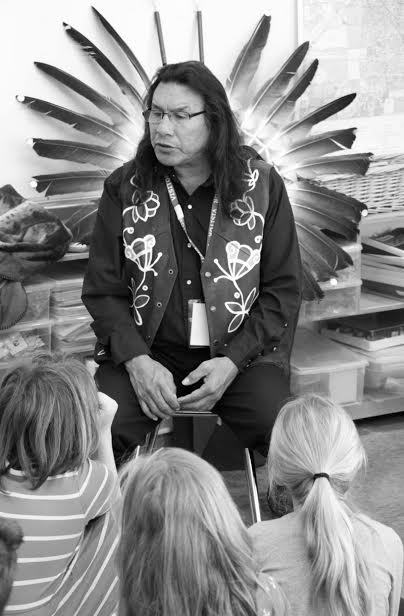Third Grade Woodland Day Evolves
Update in Curriculum’s Authenticity
Photo credit: Katrina Holceker
Third graders learn about life and culture of Native Americans.
Yearbook photos of the annual 3rd Grade Woodland Activity Day, formerly known as Woodland People Day, used to feature smiling students sitting in canoes or stringing corn necklaces while wearing white tunics and painted headbands. This year, however, students wore their own clothing, and there was not a canoe or corn necklace in sight due to curricular changes implemented over the past two years.
Changes were made after third grade teachers became concerned about the authenticity of the activities students were experiencing.
“The purpose of the day is for our third graders to learn skills that children used four to six hundred years ago here in the Chicago area,” third grade teacher Amy Przygoda said. “And we decided that they were not getting enough time, so we decided to get rid of some of the activities that were not authentic so that students could have more time honing certain skills.”
The quest for authenticity led Przygoda and her colleagues to the American Indian Association of Illinois (AIAI) in October 2013. There they met with director Dr. Dorene Wiese and presented the old curriculum along with photos of the children. According to Przygoda, Wiese helped them understand and differentiate what parts of the curriculum might be considered offensive and inauthentic and what parts were authentic and worthwhile.
Following the meeting with Wiese, the third grade team modified both the curriculum and the name. Woodland People Day became Woodland Activity Day because “Woodland People Day” offensively implied that students were actually becoming Native Americans. The event went from being a day-long event to a half-day. Bead weaving and pumpkin drying are among the eight activities that were deemed authentic and included in the updated curriculum.
Members of the Parker community, from faculty to administration to students, are in support of this decision, including Dina Levi, Director of Diversity, Equity, and Inclusion.
“I see the changes made to Woodland Activity Day as nothing but positive,” Levi said. “I think, for me, when I think about my role, it is to make sure that people feel safe and included in the environment. The changes made to Woodland Activity reflect a very concerted effort made by the teachers to make sure students learn about Native American culture in a really authentic way.”
Barbara Hunt was among the faculty members who went to the AIAI meeting. “In this particular day and age, it is a different climate, and people are thinking about things differently,” Hunt said, “and the new team third grade teachers really wanted to research the materials that they inherited and see if they still made sense today.”
In prior years there were four stations with three to four different activities at each station. Students would complete approximately sixteen activities over the course of an entire school day. These activities used to include rope making, animal tracking, cooking, birch bark basket creating, and corn necklace weaving. These activities have been eliminated from the curriculum this year.
Przygoda cites the corn necklaces as being particularly offensive. “Using food for jewelry was just not something that people did,” she said. “If they had food, they were going to eat it. Wiese said get rid of that one, so we did. There really was no actual skill that the students were learning.”











